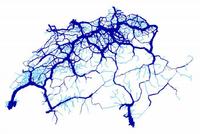|
|||||||||||
Study of the stability and variability of mobility behaviour
Direction
ETH Zurich
Prof. Dr. Kay W. Axhausen
Institute for Transport Planning and Systems (IVT)
HIL F 31.3
Stefano-Franscini-Platz 5
8093 Zurich
Tel: + 41 44 633 39 43
Fax: + 41 44 633 10 57


SVI2001/514
Partners of the IVT
büro widmer, Frauenfeld
IVT Staff
M. Löchl
K.W. Axhausen
S. Schönfelder
Client
Strassenforschung UVEK
Duration
12.2002 - 06.2006
Abstract
This report presents the results and methods used in the research project 2001/514 Untersuchung der Stabilität des Verkehrsverhaltens of the Swiss Association of Transport Engineer (SVI).
Within the project, a six week travel survey has been conducted among 230 persons from 99 households in Frauenfeld and the surrounding areas in Canton Thurgau from August until December 2003. The design built on the questionnaire used in the German project Mobidrive, but developed the set of questions further. All trip destinations of the survey have been geocoded. Moreover, route alternatives for private motorised transport and public transport have been calculated.
Moreover, the collected data has been compared with the National Travel Survey 2000 (Mikrozensus zum Verkehrsverhalten 2000), whereas differences in terms of sociodemographic characteristics of the respondents and particularly their travel behaviour couldn't be observed except for an higher proportion of GA and Halbtax ownership. For example, the average trip frequency per person and day is almost the same.
In order to check for possible fatigue effects of the amount of reported trips, several GLM (Generalised Linear Model) and poisson regression models have been estimated besides descriptive analysis. No fatigue effects could be observed in the data set.
The continuous support to the respondents and the increasing routine of the self responsible reporting of the respondents were consequently sufficient to restrain potential fatigue effects in the multi-week, longitudinal travel survey. Besides descriptive analysis of the data set, the focus has been on analysis of temporal stability and variability of travel behaviour by hazard models.
The analyses of the variability and of the rhythms as well as that of the innovation have revealed that travel behaviour is highly conditioned by habits and routines. Nevertheless, new trip destinations are added continuously, particularly for leisure travel. The majority of trips have been planned at least one or more days in advance. Moreover, it could be shown that the rhythms and therefore the temporal structure are partly dependent on the socio-demographic characteristics of the respondents, although it is just one determinant within the demand structure. The activities themselves can be divided into groups with daily, bi-daily and weekly rhythms and without a temporal structure.
In addition, the spatial dimension and distribution of trip destinations as well as the extent of activity spaces over the reporting period has been analysed through confidence ellipses, a two-dimensional version of the well-known confidence interval, and kernel density estimates of activity density.
The data base generated within the project is an important prerequisite to better understand and model the complex connection of transport supply, activity planning and execution as well as destination, mode and route choice. With this knowledge it is possible to better assess the effects of measures, particularly those which have a direct impact on daily routines.
Final report
- Löchl, M., S. Schönfelder, R. Schlich, T. Buhl, P. Widmer and K.W. Axhausen (2005) Untersuchung der Stabilität des Verkehrsverhaltens, final report, SVI 2001/514, Schriftenreihe, 1120, Bundesamt für Strassen, UVEK, Bern. Download
Publications
- Axhausen, K.W., M. Löchl, R. Schlich, T. Buhl and P. Widmer (2007) Fatigue in long-duration travel diaries, Transportation, 34 (2) 143-160.
- Greeven, P., S.R. Jara-Diaz, M.A. Munizaga and K.W. Axhausen (2005) Calibration of a joint assignment and mode choice model system, Arbeitsberichte Verkehrs- und Raumplanung, 299, IVT, ETH Zürich, Zürich.
- Löchl, M., K.W. Axhausen and S. Schönfelder (2005) Analysing Swiss longitudinal travel data, Conference Paper, STRC, Monte Verità, March 2005, Arbeitsberichte Verkehr- und Raumplanung, 276, IVT, ETH Zürich, Zürich.
- Machguth H. and M. Löchl (2004) Geokodierung 6-Wochenbefragung Thurgau 2003, Arbeitsberichte Verkehrs- und Raumplanung, 219, IVT, ETH Zürich, Zürich.
- Machguth, H., M. Löchl und M. Bürgle (2004) Berechnung von Routen- und Verkehrsmittelalternativen für den Datensatz Thurgau 2003, Arbeitsberichte Verkehrs- und Raumplanung, 231, IVT, ETH Zürich, Zürich.
- Chalasani, V.S., Ø. Engebretsen, J.M. Denstadli und K.W. Axhausen (2004) Precision of geocoded locations and network distance estimates, Arbeitsbericht Verkehrs- und Raumplanung, 256, IVT, ETH Zürich, Zürich.
Further Information
Wichtiger Hinweis:
Diese Website wird in älteren Versionen von Netscape ohne
graphische Elemente dargestellt. Die Funktionalität der
Website ist aber trotzdem gewährleistet. Wenn Sie diese
Website regelmässig benutzen, empfehlen wir Ihnen, auf
Ihrem Computer einen aktuellen Browser zu installieren. Weitere
Informationen finden Sie auf
folgender
Seite.
Important Note:
The content in this site is accessible to any browser or
Internet device, however, some graphics will display correctly
only in the newer versions of Netscape. To get the most out of
our site we suggest you upgrade to a newer browser.
More
information

